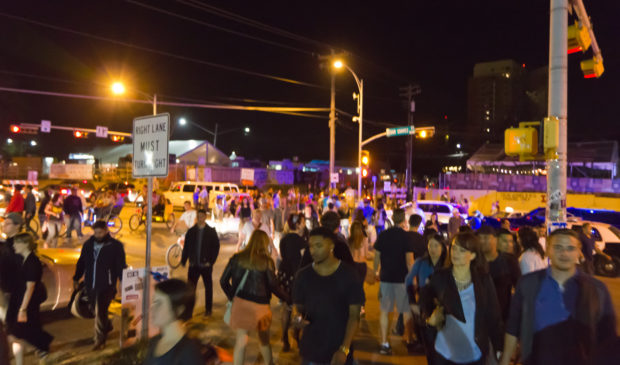Divided Council puts off Rainey funding decision
Friday, August 23, 2019 by
Jo Clifton Council Member Kathie Tovo tried mightily on Thursday to convince her colleagues to appropriate funding for projects within the Rainey Street Historic District, as Council promised when it passed a resolution to that effect in 2013.
The 2013 resolution directed staff to take money from fees generated within the district and put it into a special fund, in order to pay for relocation of historic houses being displaced by high-rises. The fund would also pay for projects emphasizing the historic nature of Rainey Street as a Latino neighborhood, and help create affordable housing.
Clarification: The 2013 ordinance that resulted from that resolution directed funding to “assist in the rehabilitation of the existing single-family structures that are relocated outside of the Rainey Street District to be used and maintained as affordable housing units; and to preserve and maintain the history of Rainey Street District.”
But the resolution new ordinance staff prepared would have created an entirely new fund and that caused pushback, not only from staff who worried that money from the Austin Transportation Department and Public Works might be reallocated, but also from Council.
After it became clear that there was significant opposition from her fellow Council members – none of whom were on the Council in 2013 – Tovo gave up and made a motion to postpone the item until Sept. 19.
Later, Tovo told the Austin Monitor via email: “With regard to this element, my Palm District Master Plan resolution directed the Manager to: (1) bring forward an ordinance that will require funds from right-of-way fees, alley vacation sales and license agreements for developments within the Rainey Street Historic District to be deposited into the Rainey Street District Fund.”
She added, “This is what the Council directed back in 2013 – but the fees, etc. only got deposited into the fund up to $600K so my 6/19 direction for an ordinance was to ‘clarify’ this original intent since staff haven’t implemented it.”
Clarification: In 2013, Council discussed the fund as an ongoing effort and asked for annual reporting from staff. However, those changes were not made to the ordinance.
In a memo to City Council, Chief Financial Officer Elaine Hart set forth staff’s reasons for opposing putting money from alley vacation, right-of-way use and license agreement fees into the Rainey Street District Fund. Between Fiscal Year 2013 and June 2019, the city deposited $600,000 into the fund, with about $507,000 of that coming from right-of-way fees and the remainder from alley vacation and license agreement fees. But the 2013 ordinance set a $600,000 ceiling on the money being transferred.
All but about $100,000 of that money has been spent.
Hart wrote that if the deposits had continued, the fund would have received $1,724,908 from the Transportation Department and about $54,000 from the Office of Real Estate Services. Instead, the money was transferred to various departments, and Hart provided a list of investments in the Rainey Street district.
The largest chunks of funding came from the Parks and Recreation Department, which, for example, has spent $995,000 on the Rainey Street pocket park and $850,000 on landscape improvements and a master plan update for the Emma S. Barrientos Mexican American Cultural Center.
Paul Saldaña and Sandra De Leon, president of the Rainey Neighbors Association, told Council that former Council Member Mike Martinez sponsored the resolution to help preserve and enhance the historic aspects of the neighborhood. De Leon said the resolution was also intended to help fund badly needed infrastructure for the neighborhood.
There has been a considerable amount of complaint about the condition of the streets and the lack of sidewalks in the neighborhood. Tovo said that then-Council Member Sheryl Cole had amended the 2013 resolution to include using the funding for sidewalks and other infrastructure. However, when the ordinance was typed up, that particular amendment didn’t make it in.
The Transportation Department has already started a pilot project to see whether some street closures might improve the situation.
Public Works Director Richard Mendoza defended his department’s record on sidewalks in the area. He said keeping sidewalks maintained was particularly difficult in the Rainey Street area because of the large amount of development. They build a sidewalk and then the developer comes in and tears it down, or damages it as a part of building a new project, he said.
Mayor Pro Tem Delia Garza that she would like to see more money put into the historic aspects of the neighborhood.
“The Hispanic community wants it identified,” she said. Even though it was not a lot of money, the money should be used for creating the historic context “showing where they used to live,” she said.
Tovo said that instead of coming back with the same resolution on Sept. 19, she will probably bring forward another one. By that time, Council will have approved the 2020 budget.
This story has been changed since publication. It originally stated that Saldaña was an aide to Martinez, which is incorrect. Clarifying language about the 2013 resolution has also been added. Photo by Steve made available through a Creative Commons license.
The Austin Monitor’s work is made possible by donations from the community. Though our reporting covers donors from time to time, we are careful to keep business and editorial efforts separate while maintaining transparency. A complete list of donors is available here, and our code of ethics is explained here.
You're a community leader
And we’re honored you look to us for serious, in-depth news. You know a strong community needs local and dedicated watchdog reporting. We’re here for you and that won’t change. Now will you take the powerful next step and support our nonprofit news organization?







